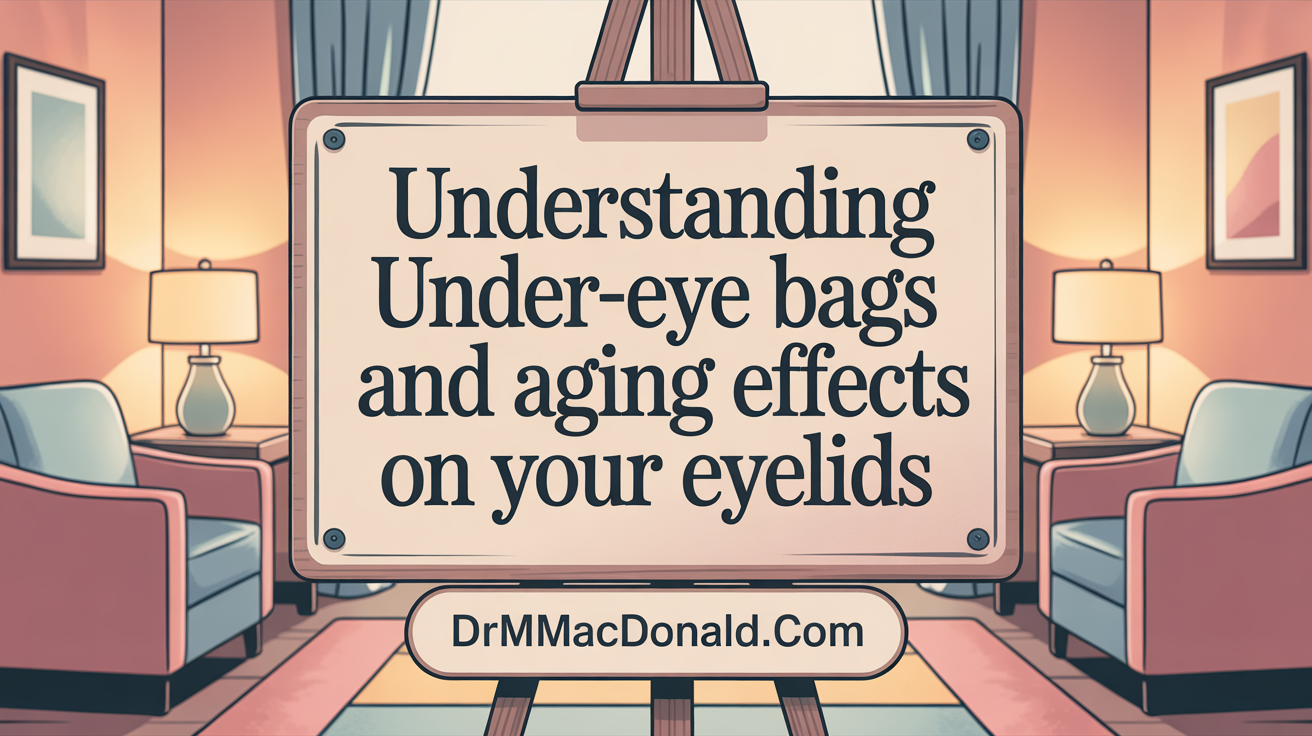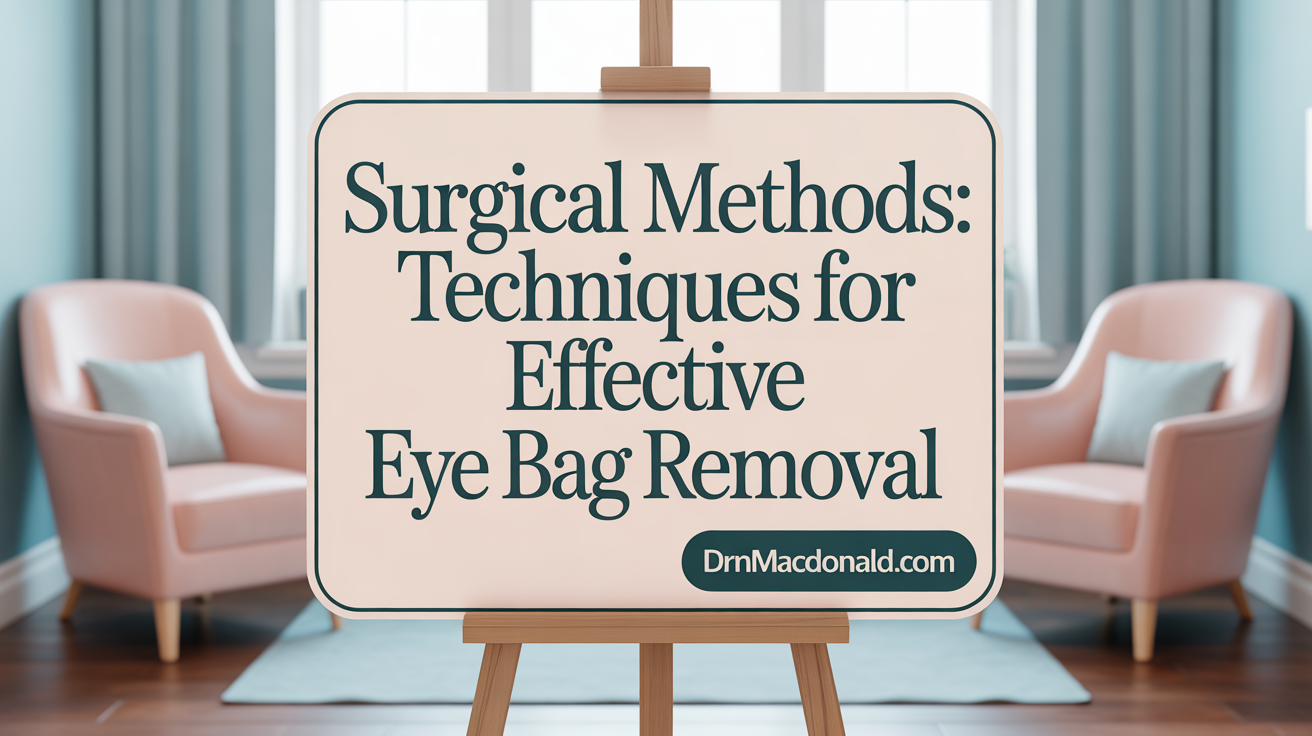Understanding Lower Eyelid Surgery
Lower eyelid surgery, also known as blepharoplasty, is a popular cosmetic procedure designed to address under-eye bags and sagging skin that contribute to a tired, aged appearance. This guide explores everything you need to know about eye bag removal—from causes and techniques to recovery and costs—helping you make an informed decision about achieving a refreshed, youthful look.
What Is Lower Eyelid Blepharoplasty and What Benefits Does It Offer?

What is lower eyelid blepharoplasty and what are its benefits?
Lower eyelid blepharoplasty is a surgical procedure aimed at rejuvenating the area around the lower eyelids. It involves removing or repositioning excess fat and skin under the eyes to create a smoother, more rested appearance.
The primary goal of the surgery is to reduce the visibility of under-eye bags and puffiness, common signs of aging. It also helps diminish wrinkles and hollows that can make one look tired or older than their age.
In addition to aesthetic improvements, the procedure can enhance functional aspects such as visual field obstruction caused by sagging skin. For those experiencing vision issues due to eyelid drooping, blepharoplasty can offer both cosmetic and functional benefits.
Typically lasting between 45 minutes and 2 hours, the surgery results can be long-lasting, often providing a youthful, vibrant look for many years. The procedure not only improves facial harmony but also boosts confidence and self-esteem.
Although generally considered safe, potential risks like swelling, scarring, or asymmetry do exist. Proper postoperative care and choosing an experienced surgeon significantly influence the success and longevity of the results.
Overall, lower eyelid blepharoplasty is an effective solution for those seeking to restore a youthful, refreshed appearance and to improve eyelid function if needed.
Causes of Under-Eye Bags and the Aging Effects on Eyelids

What causes under-eye bags and how does aging affect the eyelids?
Under-eye bags are mainly a result of natural aging processes combined with various lifestyle and genetic factors. As we age, the skin around the eyes gradually loses its elasticity and becomes thinner. This weakening of the skin and underlying muscles creates a less supportive structure, allowing fat deposits that are normally contained within the eye area to protrude forward. This produces the characteristic puffiness or swelling often seen under the eyes.
The support tissues that hold the fat and skin in place weaken over time, leading to sagging and drooping eyelids. Additionally, the skin's thinning makes blood vessels beneath more visible, which can give a darker appearance—commonly called dark circles. Fat tissue may also shift downward, causing hollowness and accentuating the bags.
Various factors can accelerate these changes, including high salt intake, allergies, sinus problems, smoking, and alcohol consumption. These habits contribute to fluid retention and inflammation, further enlarging the appearance of under-eye bags.
In summary, aging affects the eyelids by weakening tissues, thinning skin, and shifting fat deposits. While these changes often lead to cosmetic concerns like puffiness or dark circles, they can also impact vision if excess tissue obstructs the field of view. Treatments like blepharoplasty aim to restore a more youthful, rested appearance by addressing these underlying changes.
Determining Candidacy and Preparing for Lower Eyelid Surgery

Who is a suitable candidate for lower eyelid blepharoplasty and how should one prepare for the surgery?
Ideal candidates for lower eyelid blepharoplasty are individuals experiencing prominent under-eye bags, excess or sagging skin, or puffiness that contributes to a tired or aged look. This procedure can also improve vision obstructed by sagging skin. To qualify, patients should be in good general health, with no serious eye conditions such as glaucoma or retinal detachment. They should have realistic expectations about the outcomes.
Before surgery, a comprehensive preoperative assessment is essential. This includes reviewing medical history, conducting an eye examination, visual field testing, and taking detailed eyelid photographs. These evaluations help ensure that the surgery is safe and suitable for the individual.
Preparing for the procedure involves several important steps. Patients should stop blood-thinning medications, herbal supplements, and anti-inflammatory drugs as recommended by their surgeon, ideally at least one to two weeks before surgery. Quitting smoking at least four weeks beforehand is crucial because smoking impairs wound healing.
Lifestyle adjustments are also necessary. Avoiding alcohol and maintaining good hydration can support recovery. Patients should arrange transportation to and from the surgery center, as they will be sedated and unable to drive afterward. Postoperative support from family or friends can facilitate a smoother recovery.
On the day of the surgery, patients are advised to wear comfortable clothing and follow all specific preoperative instructions provided by their surgeon. Setting up a quiet, comfortable environment at home, with supplies such as cold packs, prescribed eye drops, and ointments, aids in post-surgery care.
A consultation with an experienced, board-certified plastic surgeon allows for personalized planning, ensuring that the procedure addresses individual concerns. The goal is to restore a youthful, alert look with minimal risks, and thorough preparation is a vital step toward achieving that outcome.
Surgical Techniques Used in Lower Eyelid Blepharoplasty for Eye Bag Removal
 Lower eyelid blepharoplasty employs specific surgical methods tailored to reduce under-eye bags and create a youthful appearance. One common technique is the transconjunctival approach, where an incision is made inside the lower eyelid, leaving no external scar. Through this internal incision, excess fat can be removed or repositioned, helping to smooth out bulges without affecting the skin.
Lower eyelid blepharoplasty employs specific surgical methods tailored to reduce under-eye bags and create a youthful appearance. One common technique is the transconjunctival approach, where an incision is made inside the lower eyelid, leaving no external scar. Through this internal incision, excess fat can be removed or repositioned, helping to smooth out bulges without affecting the skin.
Alternatively, external incision methods involve making a small cut just below the eyelashes. This approach allows the surgeon to excise loose skin, tighten eyelid muscles, and sometimes remove or adjust fat. The skin pinch technique, performed through this external incision, is minimally invasive and results in minimal scarring, as scars fade over time.
Fat removal and repositioning are central to the procedure. Excess fat pads are carefully excised or shifted to improve eyelid contour. In some cases, fat transfer or repositioning helps fill hollowness or deepen the tear trough, providing a more natural look.
To support the eyelids and prevent sagging or malposition, additional procedures like canthopexy or canthoplasty may be performed. These involve tightening or reinforcing the lateral canthal tendons, which stabilize the eyelid corner.
The overarching goal of these different techniques is to deliver results that look natural and long-lasting. Modern methods aim to balance fat removal, repositioning, and skin tightening, minimizing risks like eyelid malposition or uneven contours. When combined thoughtfully, these approaches restore a refreshed, youthful eye area with minimal visible scarring and enduring satisfaction.
Recovery Timeline and Post-Operative Care After Lower Eyelid Surgery
What is the typical recovery process and post-operative care for lower eyelid blepharoplasty?
The recovery process following lower eyelid blepharoplasty generally involves a period of swelling, bruising, and some discomfort. Most patients notice a significant reduction in swelling and bruising within about two weeks. During this time, many people find it advisable to take 1-2 weeks off work to allow proper healing.
Applying cold compresses frequently during the first 48 hours is a common practice to reduce swelling and minimize bruising. Patients are also encouraged to keep their head elevated, even while sleeping, to help fluid drainage and decrease swelling. Over-the-counter pain medications or those prescribed by the surgeon can help manage any discomfort.
Follow-up appointments are important for monitoring healing progress, and suture removal usually occurs between days 4 and 7 after surgery. Swelling around the eyes often improves markedly by the third week, while swelling on the cheeks and jawline can take 2-3 weeks to subside fully.
Complete healing involves scar maturation and the fading of any residual scars, which can take several months. During this period, scars typically become less noticeable, blending into the natural crease lines or inside the eyelid.
Additional care includes avoiding contact lenses for at least two weeks, protecting the eyes from sun exposure by wearing dark sunglasses, and refraining from strenuous activities or heavy lifting for about a week or as directed.
Following these post-operative care steps helps reduce the risk of complications, promotes faster healing, and ensures that the final aesthetic results are achieved with minimal scarring or other issues.
Pain, Side Effects, and Timeline for Returning to Normal Activities
How painful is lower eyelid blepharoplasty and what is the expected timeline for returning to normal activities?
Lower eyelid blepharoplasty is typically associated with minimal pain. Most patients experience some discomfort after the procedure, but this is largely manageable with prescribed pain medications and cold compresses. The use of ice packs in the first 48 hours helps reduce swelling and soothe soreness.
Common minor side effects include swelling, bruising, mild soreness, and temporary dryness or irritation of the eyes. These effects are expected and usually diminish within the first two weeks. Swelling and bruising are most prominent during the initial days but tend to decrease significantly by the end of the first week.
Most individuals can expect to resume light activities and return to work within 10 to 14 days. Strenuous exertion, vigorous exercise, and activities that increase blood flow to the eyes should be avoided for at least a week or until healing progresses smoothly. Wearing sunglasses and avoiding direct sun exposure during recovery help protect the delicate healing tissues.
Full healing involves resolution of swelling, fading of scars, and stabilization of eyelid position. Typically, by around four weeks, most swelling and bruising resolve, and patients start seeing more natural, final results. Complete recovery, including scar maturation and subtle swelling reduction, can take several months. Eye sensitivity to light and minor dryness may persist briefly but generally improve in the first few weeks.
In summary, patients should plan for a recovery period of about two weeks for most daily activities and around a month before resuming high-intensity workouts, with proper post-operative care ensuring comfortable healing and optimal results.
Risks, Complications, and How to Minimize Them in Lower Eyelid Surgery
What are the potential risks and complications associated with lower eyelid surgery?
Lower eyelid surgery, or blepharoplasty, is generally safe, but it can involve certain risks. Common issues include infection, bleeding, dry eyes, and swelling. Some patients might experience changes in eyelid position, such as ectropion (outward turning) or retraction, which can sometimes require additional procedures.
Serious but rare complications include orbital hemorrhage, which can threaten vision if not treated promptly. Vision loss, while exceedingly uncommon, is the most severe risk and demands immediate medical intervention if symptoms appear.
Additional complications can involve scarring, asymmetry of the eyelids, sensory changes like numbness, and wound healing issues. Long-term, some patients report persistent dry eyes or skin irregularities around the eyelids.
Why is the experience of the surgeon important?
Choosing a skilled, experienced surgeon is crucial for achieving safe and effective results. An expert surgeon can carefully assess individual anatomy and discuss realistic expectations. They are also more adept at minimizing tissue trauma, precise incision placement, and managing complications should they arise.
A surgeon with extensive experience in eyelid procedures will utilize advanced techniques, reducing the likelihood of noticeable scarring or eyelid malposition, and ensure proper healing.
How can proper pre- and post-operative care help reduce risks?
Preoperative preparation includes thorough medical assessments, avoiding blood-thinning medications, and quitting smoking to promote better wound healing.
Postoperative care involves following all surgeon instructions, such as applying cold compresses to reduce swelling, using prescribed eye drops or ointments, and avoiding strenuous activity for at least a week.
Wearing sunglasses can protect healing eyes from sunlight and wind, which helps prevent irritation. Attending follow-up appointments allows the surgeon to monitor healing, identify early complications, and intervene if necessary.
Implementing these precautions not only minimizes the potential for adverse outcomes but also enhances the overall success and longevity of the surgical results.
Non-Surgical Alternatives and Choosing the Right Surgeon for Your Procedure
Are there non-surgical alternatives to eye bag removal and how effective are they compared to surgery?
Yes, there are non-surgical options to improve the appearance of under-eye bags. Treatments such as dermal fillers, laser skin tightening, and newer technologies like Endolift can offer some benefits.
Fillers, typically hyaluronic acid-based, can instantly reduce hollow areas and slightly diminish puffiness by adding volume. These are especially effective for mild cases or for addressing dark circles caused by hollowness. However, fillers require regular maintenance every few months as their effects are temporary.
Laser therapies and Endolift work by stimulating collagen production and tightening the skin, leading to a more rejuvenated appearance. Results from these treatments usually last between 2 to 5 years, depending on individual skin aging and lifestyle.
Compared to surgery, non-invasive treatments involve less downtime, virtually no scarring, and lower costs. However, they often result in more modest improvements and are less effective for significant sagging, large bags, or excess skin.
Surgical blepharoplasty remains the gold standard for long-lasting, comprehensive correction, especially in cases with substantial excess skin or fat. It can provide results that last many years or even a lifetime. The best choice depends on the severity of the condition, personal preferences, and professional medical advice.
How can one choose a qualified surgeon for lower eyelid blepharoplasty?
Selecting the right surgeon is crucial for safe and satisfying results. Start by ensuring the surgeon is board-certified in plastic or oculoplastic surgery, such as by the American Board of Plastic Surgery (ABPS) or the American Academy of Ophthalmology.
Look for a surgeon with extensive experience specifically in eyelid procedures. Review their portfolio of before-and-after photos to assess their aesthetic style and success in achieving natural results.
Verify their credentials through reputable medical boards and check their surgical facility’s accreditation to ensure a safe environment.
Patient reviews and testimonials can offer insight into others’ experiences and satisfaction. Seek referrals from trusted medical professionals or friends who have undergone similar procedures.
Schedule a consultation to discuss your goals, ask about their approach, and evaluate their communication skills. Feeling comfortable and confident in your surgeon’s expertise is essential before proceeding.
By thoroughly researching and consulting with qualified specialists, you can find a surgeon best suited to meet your aesthetic goals with safety and professionalism.
Making an Informed Choice for Lower Eyelid Surgery
Lower eyelid blepharoplasty offers a highly effective solution for individuals seeking to reduce under-eye bags and rejuvenate their appearance. Understanding the causes, surgical techniques, recovery process, and potential risks is essential to set realistic expectations and achieve the best possible outcome. While non-surgical alternatives exist, surgery provides the most lasting and comprehensive results for suitable candidates. Careful preparation and selecting a qualified, experienced surgeon are critical to ensure safety and satisfaction. With proper care, patients often enjoy a refreshed, youthful look and enhanced confidence for many years following the procedure.
References
- Blepharoplasty - Mayo Clinic
- Lower Eyelid Blepharoplasty - Oculofacial Surgical Arts
- Eye Bag Surgery: Costs, Benefits, Risks, Recovery Time, and More
- Blepharoplasty (Eyelid Surgery): What It Is, Details & Recovery
- Eyelid Surgery Procedure Guide | ABCS
- Lower Blepharoplasty Beverly Hills | Under Eye Bag | Dark Circle
- The Best Guide to Eye Bag Removal: Techniques, Recovery, and ...
- Scarless and Stitchless lower eyelid bag removal | (714) 449-1940
- Lower Eyelid Lift | Eye Bag Removal - Naficy Plastic Surgery
